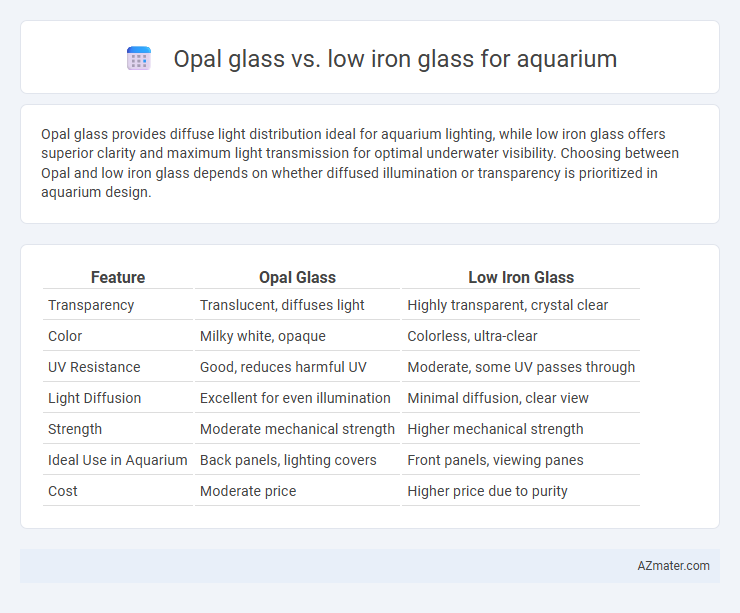Opal glass provides diffuse light distribution ideal for aquarium lighting, while low iron glass offers superior clarity and maximum light transmission for optimal underwater visibility. Choosing between Opal and low iron glass depends on whether diffused illumination or transparency is prioritized in aquarium design.
Table of Comparison
| Feature | Opal Glass | Low Iron Glass |
|---|---|---|
| Transparency | Translucent, diffuses light | Highly transparent, crystal clear |
| Color | Milky white, opaque | Colorless, ultra-clear |
| UV Resistance | Good, reduces harmful UV | Moderate, some UV passes through |
| Light Diffusion | Excellent for even illumination | Minimal diffusion, clear view |
| Strength | Moderate mechanical strength | Higher mechanical strength |
| Ideal Use in Aquarium | Back panels, lighting covers | Front panels, viewing panes |
| Cost | Moderate price | Higher price due to purity |
Introduction to Aquarium Glass Types
Opal glass offers a diffused, frosted appearance that reduces glare and enhances light distribution within aquariums, making it ideal for decorative or planted tanks. Low iron glass provides superior clarity and transparency by minimizing the green tint found in standard glass, which improves visibility and color accuracy, essential for showcasing aquatic life. Choosing between opal and low iron glass depends on whether aesthetics or maximum clarity is the priority in aquarium design.
What is Opal Glass?
Opal glass is a type of glass infused with white, opaque pigments that diffuse light evenly, creating a soft, luminous effect ideal for aquarium lighting. Unlike low iron glass, which is highly transparent and designed to enhance clarity by reducing the greenish tint, opal glass prioritizes light diffusion over transparency, minimizing glare and reflections. This makes opal glass a preferred choice for aquarium covers and light panels where uniform illumination and reduced eye strain are essential for both aquatic life and viewers.
What is Low Iron Glass?
Low iron glass, often known as ultra-clear or extra-clear glass, contains significantly reduced iron content compared to standard glass, resulting in enhanced transparency and minimal green tint. This type of glass is ideal for aquarium use as it offers superior light transmission and true color rendering, making aquatic environments appear more vibrant and natural. In contrast, opal glass has a frosted, opaque surface that diffuses light but lacks the clarity required to showcase detailed underwater scenes.
Visual Clarity: Opal Glass vs Low Iron Glass
Low iron glass offers superior visual clarity compared to opal glass due to its reduced iron content, which minimizes the greenish tint typically seen in standard glass, enhancing the true colors of aquatic life. Opal glass, while aesthetically pleasing with its frosted, translucent finish, diffuses light and obscures the view into the aquarium, making it less ideal for observing detailed aquatic environments. For aquariums prioritizing clear and vibrant underwater visibility, low iron glass is the optimal choice.
Light Transmission and Color Accuracy
Opal glass reduces glare and diffuses light evenly, enhancing visual clarity in aquariums while slightly lowering light transmission compared to low iron glass. Low iron glass offers superior light transmission, ensuring vibrant, true-to-life color accuracy and minimal distortion for aquatic displays. Aquarium enthusiasts prefer low iron glass when maximum brightness and color fidelity are critical for showcasing aquatic life.
Strength and Durability Comparison
Opal glass offers moderate strength but is primarily valued for its aesthetic diffusion of light, making it less durable under impact compared to low iron glass, which boasts superior toughness and resistance to chips or cracks due to its enhanced purity and structural integrity. Low iron glass is engineered to withstand high pressure and physical stress, essential for large or heavily stocked aquariums, whereas opal glass may degrade over time when exposed to constant water pressure or accidental impacts. Choosing low iron glass ensures long-term durability and safety, crucial for maintaining the structural stability of aquarium tanks.
Cost Differences and Value
Opal glass for aquariums generally costs more than low iron glass due to its unique light-diffusing properties that enhance underwater aesthetics. Low iron glass offers superior clarity and higher transparency at a lower price, providing excellent value for budget-conscious aquarists prioritizing visual sharpness. Choosing between opal and low iron glass depends on whether the priority is decorative diffusion or maximum clarity within the available budget.
Suitability for Planted and Reef Aquariums
Low iron glass offers superior clarity and color accuracy, making it ideal for both planted and reef aquariums where vibrant visuals and natural light penetration are crucial for coral growth and aquatic plant photosynthesis. Opal glass, with its frosted and diffused surface, reduces glare and provides a softer light effect but can diminish the intensity of light essential for demanding photosynthetic organisms. Aquarists prioritizing maximum light transmission and true color rendition typically choose low iron glass to enhance the health and aesthetic appeal of their planted or reef setups.
Maintenance and Cleaning Considerations
Opal glass in aquariums offers a matte finish that can hide minor water spots and algae, reducing the frequency of visible cleaning compared to low iron glass, which is clearer and shows dirt more prominently. Low iron glass requires more regular maintenance to maintain its crystal-clear transparency, especially in saltwater tanks where mineral deposits accumulate quickly. Both types benefit from using non-abrasive cleaning tools and avoiding harsh chemicals to preserve glass integrity and visual quality.
Which Glass is Best for Your Aquarium?
Low iron glass offers higher clarity and enhanced light transmission, making it ideal for aquarium tanks where vibrant, true-to-life colors of aquatic life are desired. Opal glass, with its frosted, diffused quality, reduces glare and provides a softer, more aesthetic background but can slightly diminish the sharpness of views inside the aquarium. For showcasing vivid underwater environments, low iron glass is generally preferred, whereas opal glass suits decorative tanks emphasizing ambient lighting and privacy.

Infographic: Opal glass vs Low iron glass for Aquarium
 azmater.com
azmater.com